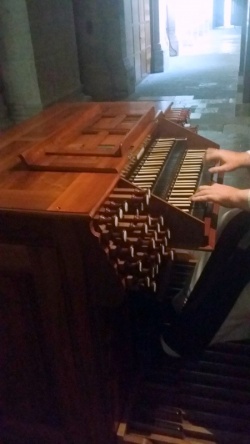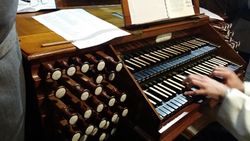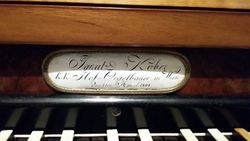Heiligenkreuz, Stiftskirche Mariä Himmelfahrt (Hauptorgel): Unterschied zwischen den Versionen
JJBB1 (Diskussion | Beiträge) |
JJBB1 (Diskussion | Beiträge) |
||
| Zeile 13: | Zeile 13: | ||
|UMBAU = | |UMBAU = | ||
|GEHÄUSE = | |GEHÄUSE = | ||
| − | |GESCHICHTE = | + | |GESCHICHTE = 1804 ursprünglich auf der Westempore errichtet |
|STIMMTONHÖHE = | |STIMMTONHÖHE = | ||
|TEMPERATUR = | |TEMPERATUR = | ||
| Zeile 22: | Zeile 22: | ||
|MANUALE = 2, C-d<sup>3</sup> | |MANUALE = 2, C-d<sup>3</sup> | ||
|PEDAL = C-f' | |PEDAL = C-f' | ||
| − | |SPIELHILFEN = Manualkoppel (Zug oberhalb Manual II); keine Pedalkoppel, Timpani<ref>D/Dis als Dissonanz klingend </ref> | + | |SPIELHILFEN = Manualkoppel (Zug oberhalb Manual II); keine Pedalkoppel, Timpani 8'<ref>D/Dis als Dissonanz klingend </ref>, |
| + | Epist(omium) Man. (Sperrventil für Manuallade), Epist(omium) Ped. (Sperrventil für die Pedallade); | ||
| + | |||
| + | Tremolo Manual, Tremolo Pos., Tremolo Ped., Kalkantenzug, Relax venti (Windausströmung Orgelkasten), Intonation (Dreiklang) am Orgelkasten | ||
| + | |||
}} | }} | ||
| Zeile 29: | Zeile 33: | ||
|WERK 1 = I Hauptwerk | |WERK 1 = I Hauptwerk | ||
|REGISTER WERK 1 = Quintit 16’ | |REGISTER WERK 1 = Quintit 16’ | ||
| − | + | Reg(ula) Prim(aria) 8’ <ref>entspricht Prinzipal 8'</ref> | |
| − | + | Quintit 8’ | |
| − | + | Salicional 8’ | |
| − | Viola da Gamba | + | Viola da Gamba 8' |
| − | + | Coni 8' <ref>entspricht Spitzflöte 8'</ref> | |
| − | + | Flauto travers 4’ <ref>seit 1952, urspr. Flauto traverso 8'</ref> | |
| − | + | Tib(ia) silv(estris) 8' | |
| − | + | Unda marina 8' <ref>Flöte 8', schwebend ab c'</ref> | |
| − | + | Piffaro 4’ <ref>Principalschwebung</ref> | |
| − | + | Diapason 4' <ref>Oktav 4'</ref> | |
| − | + | Tib(ia) amab(ilis) 4' <ref>Flöte 4' offen</ref> | |
| − | + | Cor nott(urnum) 4' <ref>Weitflöte 4'</ref> | |
| − | + | Diapente 2<sup>2</sup>/<Sub>3</Sub>’ <ref>Prinzipalquinte</ref> | |
| − | + | Disdiapason 2’ <ref>Superoktave 2'</ref> | |
| − | + | Cimbal 2fach 4' <ref>Gedeckt 4'+Oktave 2'</ref> | |
| − | + | Misc(ella) acut(a) 5fach 4’ <ref>4' + 2' + 2 2/3' + 1 3/5' + 1 1/3'</ref> | |
| − | + | Miscella 4fach 2’ <ref>2' + 1' + 1/3' + 1/5'</ref> | |
| − | + | Sesquialter 3fach 2’ <ref>1' + 1 1/3' + 4/5'</ref> | |
| − | Tuba 16‘ | + | Tuba 16‘ <ref>entspricht Trompete 16'</ref> |
| − | Vox humana 8‘ | + | Vox humana 8‘ <ref>Kegelregister</ref> |
|WERK 2 = II Positiv | |WERK 2 = II Positiv | ||
| − | |REGISTER WERK 2 = Pileata maior 8’ | + | |REGISTER WERK 2 = Pileata maior 8’ <ref>Gedeckt 8' |
Quintit 8’ | Quintit 8’ | ||
| − | + | ||
| + | Avena 8' (B) | ||
| + | |||
| + | Flauto trav. 8' (D) | ||
| + | |||
| + | |||
| + | Reg(ula) Prim(aria) 4’ <ref>Kleinprinzipal</ref> | ||
| + | |||
| + | Fugara 4' | ||
| + | |||
| + | Pileata minor 4’ <ref>Kleingedeckt</ref> | ||
Dulciana 4’ | Dulciana 4’ | ||
| − | + | Diapason 2' <ref>Superoktave 2'</ref> | |
| − | + | Gamba dupl. 4'+2' | |
| − | + | Disdiapason 1 1/3' <ref>Kleinquinte</ref> | |
| − | + | Miscella 5fach 2' <ref>2' + 2 2/3' + 1' + 4/5' + 2/3'</ref> | |
| − | |||
| − | + | Oboe 8' (D) | |
| − | + | Fagott 8' (B) | |
| − | |||
| − | |||
|WERK 3 = Pedal | |WERK 3 = Pedal | ||
| − | |REGISTER WERK 3 = Pileata muima 32’ | + | |REGISTER WERK 3 = Pileata muima 32’ <ref>Untersatz 32</ref> |
| − | Regula primaria 16’ | + | Regula primaria 16’ <ref>Prinzipal 16'</ref> |
| − | + | Pile(ata) maior 16’ | |
Violon 16’ | Violon 16’ | ||
| − | + | Diapason 8' | |
| − | + | Violon 8' | |
| − | + | Violoncello 8' | |
| − | + | Diapente 5<sup>1</sup>/<Sub>3</Sub>’ | |
| − | + | Disdiapason 4' | |
| − | Cor | + | Cor not(turno) 4’ |
| − | + | Cornu 3fach 2<sup>2</sup>/<Sub>3</Sub>’+2’+ 1<sup>3</sup>/<Sub>5</Sub>’ | |
| − | + | Buccina 32‘ <ref>Posaune 32'</ref> | |
| − | + | Buccina 16' | |
| − | + | Miscella maior 4fach 4’ | |
Fagotto 8‘ | Fagotto 8‘ | ||
Tuba 8’ | Tuba 8’ | ||
| + | |||
| + | Cornu 8' | ||
Tuba 4’ | Tuba 4’ | ||
Version vom 30. Oktober 2018, 11:21 Uhr
Adresse: A-2500 Heiligenkreuz, Niederösterreich, Österreich
Gebäude: Zisterzienserstift Heiligenkreuz, Stiftskirche Mariä Himmelfahrt
Weitere Orgeln: Hauptorgel, Chororgel
Datei:Heiligenkreuz-Hauptorgel.jpg Ignaz Kober aus 1804 |
| Orgelbauer: | Ignatz Kober, Wien |
| Baujahr: | 1804 |
| Geschichte der Orgel: | 1804 ursprünglich auf der Westempore errichtet |
| Windladen: | Schleifladen |
| Spieltraktur: | mechanisch |
| Registertraktur: | mechanisch |
| Registeranzahl: | 50 |
| Manuale: | 2, C-d3 |
| Pedal: | C-f' |
| Spielhilfen, Koppeln: | Manualkoppel (Zug oberhalb Manual II); keine Pedalkoppel, Timpani 8'[1],
Epist(omium) Man. (Sperrventil für Manuallade), Epist(omium) Ped. (Sperrventil für die Pedallade); Tremolo Manual, Tremolo Pos., Tremolo Ped., Kalkantenzug, Relax venti (Windausströmung Orgelkasten), Intonation (Dreiklang) am Orgelkasten |
Disposition
| I Hauptwerk | II Positiv | Pedal |
| Quintit 16’
Reg(ula) Prim(aria) 8’ [2] Quintit 8’ Salicional 8’ Viola da Gamba 8' Coni 8' [3] Flauto travers 4’ [4] Tib(ia) silv(estris) 8' Unda marina 8' [5] Piffaro 4’ [6] Diapason 4' [7] Tib(ia) amab(ilis) 4' [8] Cor nott(urnum) 4' [9] Diapente 22/3’ [10] Disdiapason 2’ [11] Cimbal 2fach 4' [12] Misc(ella) acut(a) 5fach 4’ [13] Miscella 4fach 2’ [14] Sesquialter 3fach 2’ [15] Tuba 16‘ [16] Vox humana 8‘ [17] |
Pileata maior 8’ Referenzfehler: Für ein <ref>-Tag fehlt ein schließendes </ref>-Tag.
Fugara 4' Pileata minor 4’ [18] Dulciana 4’ Diapason 2' [19] Gamba dupl. 4'+2' Disdiapason 1 1/3' [20] Miscella 5fach 2' [21]
Fagott 8' (B) |
Pileata muima 32’ [22]
Regula primaria 16’ [23] Pile(ata) maior 16’ Violon 16’ Diapason 8' Violon 8' Violoncello 8' Diapente 51/3’ Disdiapason 4' Cor not(turno) 4’ Cornu 3fach 22/3’+2’+ 13/5’ Buccina 32‘ [24] Buccina 16' Miscella maior 4fach 4’ Fagotto 8‘ Tuba 8’ Cornu 8' Tuba 4’ |
Bibliographie
| Anmerkungen: | Die Beschränkung dieses Instruments auf 2 Manuale bei 50 Registern entsprach dem damaligen Zeitgeist, ebenso wies das Pedal ursprünglich nur 12 Töne auf 18 Tasten aus, was aber in weiterer Folge 1952 auf C-f' erweitert wurde.
Im Zuge der Kirchenrestuaurierung waurde das barocke Chorgestühl abgetragen und man entschloß sich in weiterer Folge dieses Instrument im nördliche Querschiff aufzustellen. Dazu wurde das Kobergehäuse mit einem neuen Untergehäuse versehen und das Rückpositiv in das Hauptgehäuse angefügt (vgl. Forer, Orgeln in Österreich, S. 110). |
- ↑ D/Dis als Dissonanz klingend
- ↑ entspricht Prinzipal 8'
- ↑ entspricht Spitzflöte 8'
- ↑ seit 1952, urspr. Flauto traverso 8'
- ↑ Flöte 8', schwebend ab c'
- ↑ Principalschwebung
- ↑ Oktav 4'
- ↑ Flöte 4' offen
- ↑ Weitflöte 4'
- ↑ Prinzipalquinte
- ↑ Superoktave 2'
- ↑ Gedeckt 4'+Oktave 2'
- ↑ 4' + 2' + 2 2/3' + 1 3/5' + 1 1/3'
- ↑ 2' + 1' + 1/3' + 1/5'
- ↑ 1' + 1 1/3' + 4/5'
- ↑ entspricht Trompete 16'
- ↑ Kegelregister
- ↑ Kleingedeckt
- ↑ Superoktave 2'
- ↑ Kleinquinte
- ↑ 2' + 2 2/3' + 1' + 4/5' + 2/3'
- ↑ Untersatz 32
- ↑ Prinzipal 16'
- ↑ Posaune 32'






